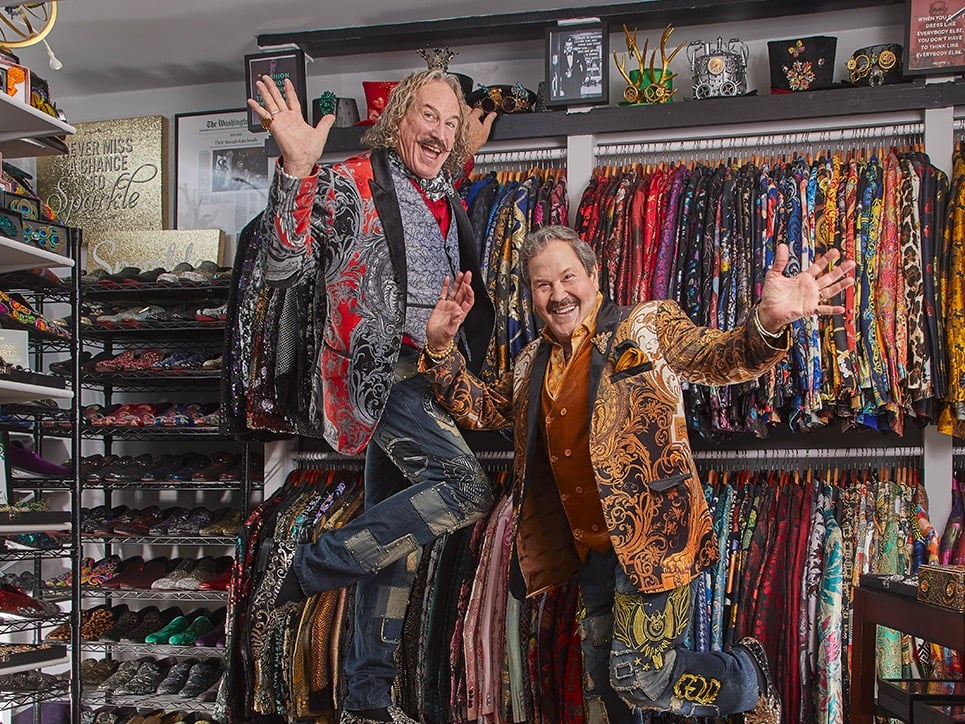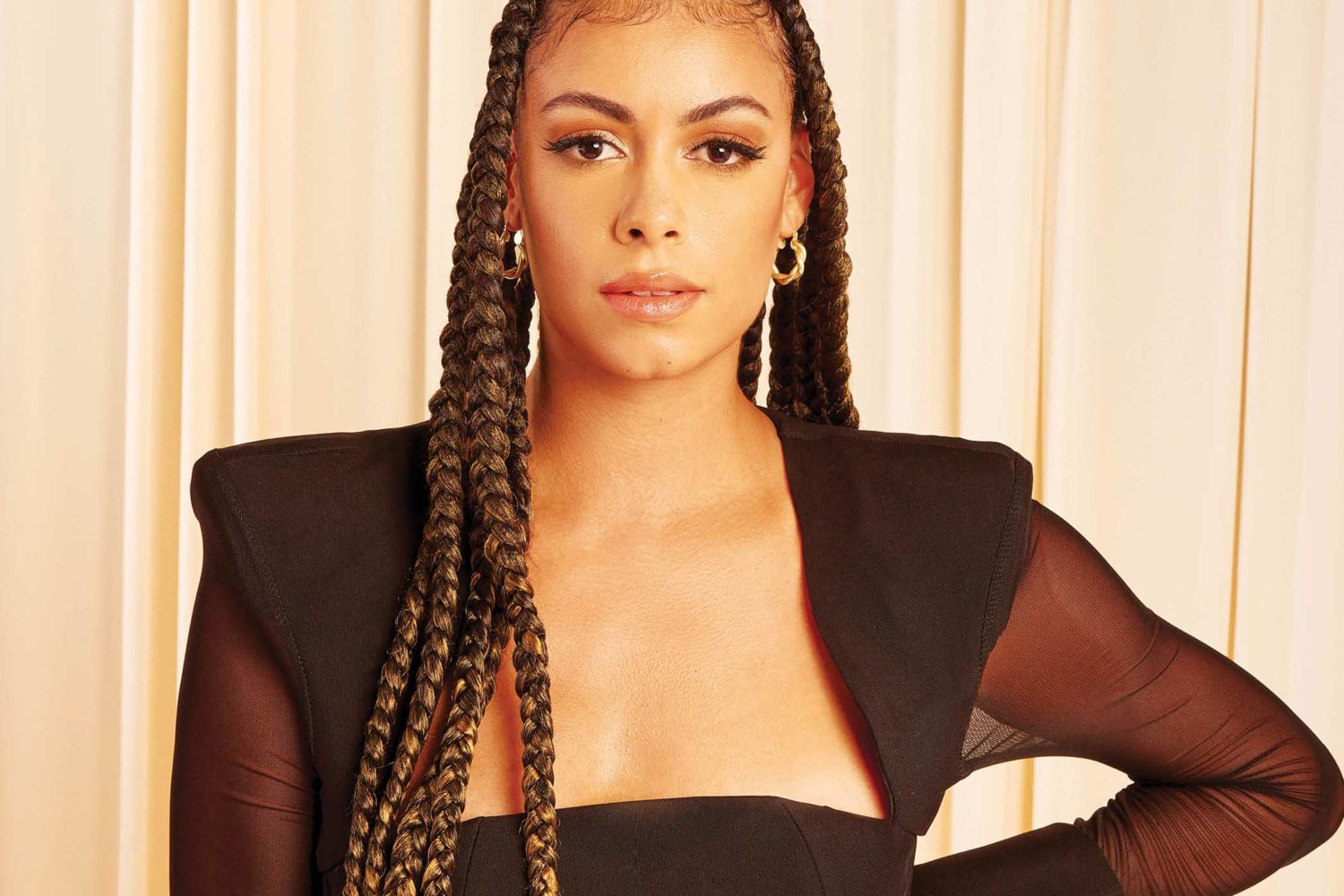Kristen Freeman has eight pairs of eyeglasses and four pairs of sunglasses. “They are an accessory for every mood and role: studious or flirty, mom, wife, program manager, personal trainer,” says Freeman. “After getting a lot of compliments on purple frames, I bought clothes to go with them.”
At offices and cocktail parties, more Washingtonians are sporting cool glasses. Some have a wardrobe of frames; others have one pair they wear to work, another for their weekend personality.
“Very bold, edgy styles like Alain Mikli frames are selling extremely well here,” says Virginia Burton of Burton Optician in Georgetown. “In addition to their unusual shapes, the color combinations are not what you’d expect to see: russet and lime, chocolate and turquoise, purple and orange.
“One of my clients, Ralph Moss, has 100 pairs,” says Burton. “Twenty are identical frames in different colors.”
If you wear glasses, maybe you have trouble picking one pair, let alone two or three. The standard advice when choosing frames is to start with face shape.
There are seven basic face shapes: round, oval, oblong, base-down triangle, heart-shaped, diamond (prominent cheekbones), and square. The shape of your eyeglasses should contrast with your face shape. If you follow that rule, you wouldn’t put a square frame on a square face. But rules can be broken.
“People have been brainwashed into thinking that there are rules about what shape frame each face needs,” says Burton. “It’s really simple: If you have a feature you don’t like, don’t repeat it in the frame. If you don’t like your square jaw, don’t wear a frame that’s square on the bottom. But if you love your round face and wear your hair in ringlets, then go ahead and get a round frame. Let yourself go. Glasses are just another accessory to enjoy.”
June Mines of These Eyes of Mines in Northeast DC, which carries vintage and designer frames, agrees. “I don’t play by the face-shape rules,” she says. Instead, she starts by assessing a client’s personality.
Skin Coloring and Hair
One guideline you might want to pay attention to: Avoid a frame that’s the same color as your eyes—it dilutes the beauty of both.
Don’t worry about frame color clashing with your clothes unless you wear only red. But you might want to pay attention to skin tone. Even if you looked fabulous in blue frames in high school, skin changes. People with pale skin, for example, might not look best in yellow or apple-green frames. Red would emphasize a ruddy complexion.
Eyebrows matter—thick or thin, high or low—as do beards and sideburns. Mike Pelivanis, owner of the three Apex Optical stores in DC and Maryland, advises men with a lot of facial hair to balance things out with a light frame. For anyone with prominent dark eyebrows, a thick dark frame may not be flattering. The distance between your eyes, the shape of your nose, the size of your head, and the position of your cheekbones are other considerations.
“Some glasses won’t work with prominent cheekbones—the frames would sit uncomfortably on the cheeks,” says Pelivanis, who has been in the business 30 years.
Metal or Plastic?
The latest frame innovations are in titanium, says Gary Goodsell of Eyecentral in McLean. Both titanium and high-grade stainless steel are more lightweight, resilient, flexible, and durable than the nickel-alloy frames of the 1990s and most plastic frames. Good-quality titanium and stainless frames start at about $250, plastic frames at $150.
There is a range of plastic quality, although all plastic frames are made from a cotton byproduct called cellulose acetate that is formulated for eyeglasses. Better plastic frames have more give, which reduces or eliminates the need for spring hinges. Durability isn’t much of an issue anymore: Most frames—some are now entirely bendable—outlast style changes.
The most delicate materials are bamboo and wood, which create natural and different-looking frames. “If you have five or six pairs of glasses,” says Goodsell, “then go for one in wood or bamboo.” But these are also among the most expensive frames, starting at about $600.
Better Vision
Lens technology continually improves. There are lenses that make better use of the glass surface to give wearers a bigger field of vision—for reading, computer use, and desk work—without increasing lens size. Antiglare treatments have gone state of the art, and Teflon coatings repel dust and dirt.
Photochromic lenses that turn from clear to sunglass lenses have improved but still don’t work well for driving: The windshield’s ultraviolet filter blocks out the rays that change the lenses from clear to dark.
Because opticians work with lenses more closely than do the ophthalmologists prescribing them, a good optician can help you decide what kind of lens you need—for example, bifocal or progressive. Some progressive lenses work better than others for certain people. A good optician can also tell you whether your reading glasses should have antireflective or polarized lenses, which some people can’t or shouldn’t wear.
Frame Trends
Opticians are seeing frames get larger, more angular, and more dramatic, especially for women.
After brown and black, red is the most popular color, but white is also hot, as are patterns like checks, wavy stripes, and animal prints. With a few exceptions, the use of color and design is possible only with plastic frames.
Frame colors aren’t just about fashion. “A few frame lines such as Lafont have determined that certain colors on the back side of frames have a flattering effect, reflecting light off the skin and making the frame appear lighter,” Goodsell says.
Some young women are buying frames adorned with rhinestones or crystals. Frame temples are getting thicker and more prominent and are being designed in a contradictory color.
The more distinctive the frame, the more limited the supply—so wearers won’t see their eyeglasses across a crowded room. Chanel, Judith Leiber, and other high-end designers, in what seems counterintuitive, discontinue styles if they’re getting too popular.
Government-relations professional Ralph Moss, the hundred-pair man, has his frames custom-made. “I travel a lot and am recognized for my bespoke frames,” he says. “They are a style that architect Philip Johnson wore, by Anglo American.”
The company reintroduced the style with a thinner frame, but Moss prefers the original thicker frame and custom-orders them through Burton Optician for $350 a pair. “An 84-year-old man makes them by hand, and it takes four to six months,” he says.
Where to Buy Fashionable Frames
These are eight great places to buy stylish frames. If you have a current prescription from your own eye doctor, you can shop anywhere.
Apex Optical Co., 2001 L St., NW, 202-466-8344; 4200 Wisconsin Ave., NW, 202-244-1308; 10317 Westlake Dr., Bethesda, 301-767-5900. Owner Mike Pelivanis is a meticulous optician with an experienced staff and a wide variety of frames.
Blink Optical, downtown DC, 202-776-0999; Dupont Circle, 202-234-1051; Georgetown, 202-625-5351; Alexandria, 703-518-5007; blinkoptical.com. Blink specializes in handmade frames, including exotic woods and buffalo horn.
Burton Optician, 3252 Prospect St., NW; 202-965-0346; burtonoptician.com. Customers—some from New York and Los Angeles—enjoy the one-on-one attention and advice of owner Virginia Burton. The Georgetown shop’s stock includes Judith Leiber, Gail Spence, moderately priced Kala, and colorful metals by Grant Italia.
Eyecentral, Drs. Reed, Fissel, and Udoff, 6740 Old McLean Village Dr., McLean, 703-356-1292; 635 Pennsylvania Ave., SE, 202-546-2838; eyecentral.net. Optician Gary Goodsell travels the world to buy frames. He stocks both classic and trendy designs, including Chanel, Kliik Denmark, Ronit Furst (hand-painted in Israel), Skaga’s architectural temples, and sexy Jai Kudo metals.
Georgetown Opticians, 1307 Wisconsin Ave. NW; 202-337-8237; georgetownoptician.com. One of the few places that sell oddly shaped Theo frames from Belgium, luxurious Kieselstein-Cord, and affordable Mosley Tribes.
Lenscrafters, 17 locations in Maryland and Virginia; lenscrafters.com. This global chain is owned by Luxottica, which manufactures Chanel, Bvlgari, Dolce & Gabbana, Brooks Brothers, Persol, Prada, and Ray-Ban.
These Eyes of Mines, by appointment only, 3828 26th St., NE; 202-269-0624; theseeyesofmines.com. June Mines, who operates out of a home showroom, will not sell two identical frames. If she buys two Anne et Valentin frames from France, they will be different colors. She also has vintage glasses and $5-to-$10 bargains.
Voorthuis Opticians, eight area locations; voorthuis.com. Alongside traditional frames and its in-house brand, Voorthuis’s selection includes Gucci, Cartier, and Porsche.


















